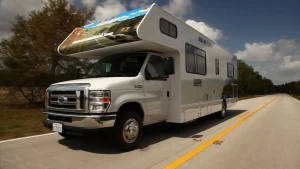If you’ve ever struggled to picture 30 feet long, you’re not alone. Feet as a unit can feel abstract until you line them up next to real things you know. In this article you’ll find 12 everyday and surprising objects that are about 30 feet long, clear comparisons that make the distance visual, quick conversions, and practical tips for measuring or planning around a 30-foot space. Read on and you’ll walk away with a reliable mental ruler you can use for home projects, moving, boating, or teaching kids about distance.
Quick conversions and simple facts about 30 feet long
- 30 ft = 360 inches.
- 30 ft = 10 yards.
- 30 ft = 9.144 meters.
- Average adult step ≈ 2.5 ft → ~12 steps to walk 30 ft.
- Average story height ≈ 10 ft → ~3 stories tall.
(These conversions will help you quickly compare or sketch a 30-ft measurement on plans.)
12 Things That Are About 30 Feet (ft.) Long
1. A 30-Foot RV
Many travel trailers and smaller Class A/B motorhomes are built around the 30-foot mark. A 30-ft RV is large enough for a private bedroom, kitchen, bathroom, and seating area, yet still manageable on two-lane roads and in typical campgrounds.
Why it matters: If you’re renting a campsite or planning a road trip, knowing your RV is about 30 feet long helps with site reservations, parking, and towing capacity.
2. A 30-Foot Sailboat / Cruiser
A large number of coastal cruising sailboats and performance cruisers come in the 28–32 ft range. A 30-ft sailboat offers comfortable accommodations for a small family and good offshore capability for weekend passages.
Practical tip: When planning a slip or mooring, check marina length limits — a 30-ft boat needs slightly longer than 30 ft clearance for fenders and lines.
3. A Midsize City Bus
Some city transit buses and shuttle buses are designed at about 30 feet (shorter than full-size 40-ft buses). These are common on narrower streets and for shuttle services.
Use case: When visualizing urban scalability, think of one of these buses occupying a curb lane — that’s a 30-ft chunk of road.
4. A Typical Backyard Pool
Common residential pool lengths range from 24–40 ft, and 30 ft is a very typical mid-sized backyard pool. It’s big enough for laps, play, and pool furniture around the perimeter.
Design tip: A 30-ft pool fits comfortably into most suburban yards without dominating the entire lot; remember to add decking and safety buffer zones.
5. Three Stories
If one story ≈ 10 ft, then a three-story house (including floor thickness) will reach roughly 30 ft. Use this when estimating height clearance, scaffolding size, or visual impact on a street.
Safety note: Local building codes and fire department access rules often reference story count — converting to feet makes it easier to communicate with contractors.
6. A 30-Foot Moving Truck or Box Truck
Full-sized moving trucks typically range from 24–26 ft, but larger box trucks and commercial rental options can approach 30 ft. This size is often used for 3-4 bedroom moves.
Moving tip: When booking, compare cubic capacity (not just length). A 30-ft truck provides substantially more volume than a 20-ft unit.
7. Ten Yards on a Football Field
On a football field each marked yard is 3 feet; therefore 10 yards equals 30 feet. This makes football field markings an excellent quick visual for 30-foot distances.
Quick activity: Walk ten yard lines on a field to feel what 30 feet actually is — great for teaching children distance concepts.
8. Two Average Cars End-to-End
A typical mid-size car is roughly 14–15 feet long. Line two of them up bumper to bumper and you’re right around 30 feet.
Practical example: Use this when estimating parking lot space, driveway lengths, or staging vehicles for photos.
9. A Standard Extension Ladder Fully Extended
Contractor extension ladders commonly come in 24, 28, and 30-foot lengths. A 30-ft ladder is commonly used for roofing, exterior painting, and tree work on two-story houses.
Safety reminder: Always set an extension ladder at a 4:1 base-to-height ratio (1 foot out for every 4 feet up) — for 30 ft height, the base should be ~7.5 ft from the wall.
10. A Lighting or Flagpole
Commercial flagpoles and parking-lot light poles commonly range from 20 to 40 feet, with 30 ft a popular middle ground. A 30-ft flagpole gives a prominent display without overly complex foundation requirements.
Tip for planners: A 30-ft pole needs a proper base and anchor; consult product specs and local codes for wind load considerations.
11. A Small Aircraft Fuselage (e.g., Cessna 172)
Light single-engine aircraft such as the Cessna 172 have fuselage lengths in the high 20-feet range (≈27 ft). It’s close enough to 30 feet long that picturing one gives a good sense of the size.
Why this helps: If you’ve seen a small airplane on a runway, imagine lining up a couple of them to understand larger distances.
12. A Mature Shade Tree
A lot of commonly planted shade trees reach 25–40 feet at maturity, so a 30-ft tall oak or maple is a realistic and vivid example of this length.
Landscape tip: When siting a tree, remember mature spread as well as height — a 30-ft tall tree will often have a wide root zone and canopy.
Why these comparisons are useful (and how to use them)
Knowing real-world objects that measure about 30 feet long helps in many scenarios:
- Homeowners & DIYers: Plan decking, pools, garages, and driveways with a better sense of scale.
- Movers & Renters: Choose the right size moving truck or RV plug-in.
- Teachers & Students: Use tangible objects (cars, ladders, football yards) to teach measurement.
- Planners & Landscapers: Visualize tree spacing, pole heights, and building impacts.
Practical tips for measuring or planning around 30 feet
- Use a tape measure or laser distance tool when accuracy matters. A 30-ft tape covers the full length; for longer distances, use a reel tape or laser.
- Walk it out: average step ~2.5 ft → roughly 12 steps = 30 ft. Good for quick checks.
- Sketch to scale: on graph paper where 1 square = 1 ft, draw a 30-square line to visualize placement.
- Allow clearance: when sizing a boat slip, RV spot, or truck, add 3–5 ft for maneuvering and safety.
- Check local codes: many planning permissions and setbacks are given in feet — convert story or yard requirements to feet to avoid mistakes.
Visuals and images to include (recommended)
- Comparison infographic: side-by-side silhouettes of a 30-ft RV, a sailboat, two cars, and a ladder with a labeled scale.
- Photographic examples: a 30-ft backyard pool, a midsize bus, a 3-story house — include alt text (examples below).
- Quick conversion table: 30 ft → 9.144 m, 360 in, 10 yd — easy copy for readers.
- Example alt text: “Midsize RV parked beside a 30-foot measuring tape showing 30 feet long.”
FAQ — Frequently asked questions about 30 feet
Q: How many meters is 30 feet?
A: 30 feet = 9.144 meters. Use this when ordering materials or consulting metric plans.
Q: How many steps is 30 feet?
A: About 12 steps, assuming an average adult step of roughly 2.5 feet.
Q: Can a 30-ft RV fit in a standard driveway?
A: Many suburban driveways are shorter than 30 ft; always measure your driveway length and add clearance for hitching and maneuvering. A 30-ft RV will need extra room for safe parking.
Q: Is a 30-ft ladder long enough for a two-story house?
A: Usually yes — a typical two-story house wall is around 20–24 ft to the roofline. A 30-ft ladder gives extra reach, but always follow ladder safety and angle guidance.
Q: How many cars equal 30 feet?
A: Roughly two average cars (each about 14–15 ft). Two small cars plus small gaps ≈ 30 ft.
Conclusion
By now you should be able to picture 30 feet long clearly: a midsize RV, a backyard pool, a three-story height, or ten yards on a football field. These comparisons make distance practical whether you’re planning a renovation, booking a moving truck, sizing a boat slip, or teaching measurement to kids.





